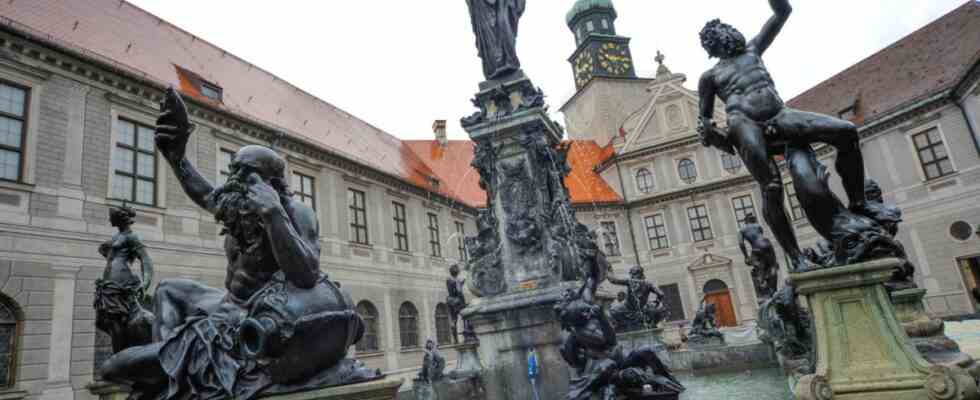They are a natural part of the cityscape as a mostly decorative accessory: there are around 700 fountains in Munich, mainly in parks or in public squares. Many of these water dispensers come from historical times, they are listed monuments, but there are also completely modern objects. Drinking water even gushes out of some of them. But the fountains are often literally in the shadow of large buildings. The day of the open monument on Sunday offers a small discovery tour “with stories about the princely and civil water through the ages”. Free tickets for all guided tours and lectures are available from 10.45 a.m. in the inner courtyard of the State Office for the Preservation of Monuments at Hofgraben 4.
The walk at 11 a.m. and 1 p.m. with the monument expert Harald Gieß is about fountains in the old town – between Marienplatz and the State Chancellery. The little journey starts with a classic, the fish fountain at Marienplatz. A popular meeting place is the and a landmark in front of the New Town Hall. The origins go back to the 14th century. Much has changed over time in terms of shape and ornamental figures. The fountain was destroyed in World War II and rebuilt in 1954 by Josef Henselmann.
The Wolfsbrunnen (also known as the Little Red Riding Hood fountain), which dates back to 1904, is a little less well known at the Kosttor near the Hofbräuhaus. The sculptors Heinrich Düll and Georg Pezold created the depiction of Little Red Riding Hood with the wolf, and four wolf heads also serve as gargoyles. The clients, Adolf and Apollonia Wolf, wanted to immortalize their name in the cityscape with the fountain.
The four water-spitting wolf heads…
(Photo: Veronica Laber)
…frame the Little Red Riding Hood standing on a pillar at the Wolfsbrunnen near the Hofbräuhaus.
(Photo: Veronica Laber)
The Kronprinz-Rupprecht-Fountain in the rear area of the residence opposite the Marstall building is particularly worth seeing. In 1961 Bernhard Bleeker designed an object with two bowls. The figure of Justitia not only holds the scales of justice but also a Pallas Athena, which stands for victory as well as for art and science. The fountain was commissioned by the Bavarian Academy of Sciences, whose premises are in the immediate vicinity. Crown Prince Rupprecht, the son of the last Bavarian King Ludwig III, was an honorary member of the Academy.
One of the oldest and largest fountains in Munich is just a few steps away, in the courtyard of the Residenz. It was completed in 1623 by Hans Krumpper and Hubert Gerhard in the Renaissance style. The fountain was not always in this place, for a short time it was on Rindermarkt. The tour ends at the State Chancellery – with a visit to the fountain house with pumping station designed by Leo von Klenze. “Fountains were often far more than just water dispensers,” says Gieß. “They were also an expression of the fact that one could afford to gild water visibly.”
Searching for clues, discovering history and stories behind historical buildings – that is the motto of this year’s monument day. During his tour of the old town (at 2 p.m. and 4 p.m.), Burkhard Körner from the Bavarian State Office for the Preservation of Monuments wants to show which structures and structural remains date back to the Middle Ages – the focus here is on St. Peter’s Church, the Old Court or the Lion Tower on the cattle market. However, Körner also wants to devote himself to the topic of reconstruction after the destruction of the Second World War – with its changes in the cityscape, but also with the buildings that preserve the character of the old town.
The lion tower at Rindermarkt dates back to the Middle Ages.
(Photo: Catherine Hess)
A separate tour revolves around the magnificent windows in Munich’s Liebfrauendom.
(Photo: Stephan Rumpf)
“On the trail of the centuries of windows” is Susanne Fischer from the Monuments Office during guided tours at 11:30 a.m. and 2:00 p.m. in the Liebfrauendom. The meeting point is the north tower chapel inside the cathedral. The stained glass there dates back more than 500 years and they show very different styles. In the choir area, the medieval works are still preserved. The modern windows can be found further back in the church room. Much was lost during the war, for example all of the 19th-century windows. Artists created modern glass paintings for the rebuilt cathedral. Susanne Fischer investigates what traces the centuries have left on the windows and who was responsible for the design.
On Sunday, the State Office for the Preservation of Monuments in the Alte Münze am Hofgraben opens its doors from 11 a.m. to 5 p.m. From 10.45 a.m. there are free tickets for participants, for example for the fountain tour and the tour through the old town. You can visit the picture archive and the restoration workshops of the state office. In addition to the guided tours, there is also a children’s program, exhibitions and lectures. For example, at 4.15 p.m. General Curator Mathias Pfeil will speak about the reconstruction of Munich after the Second World War.

